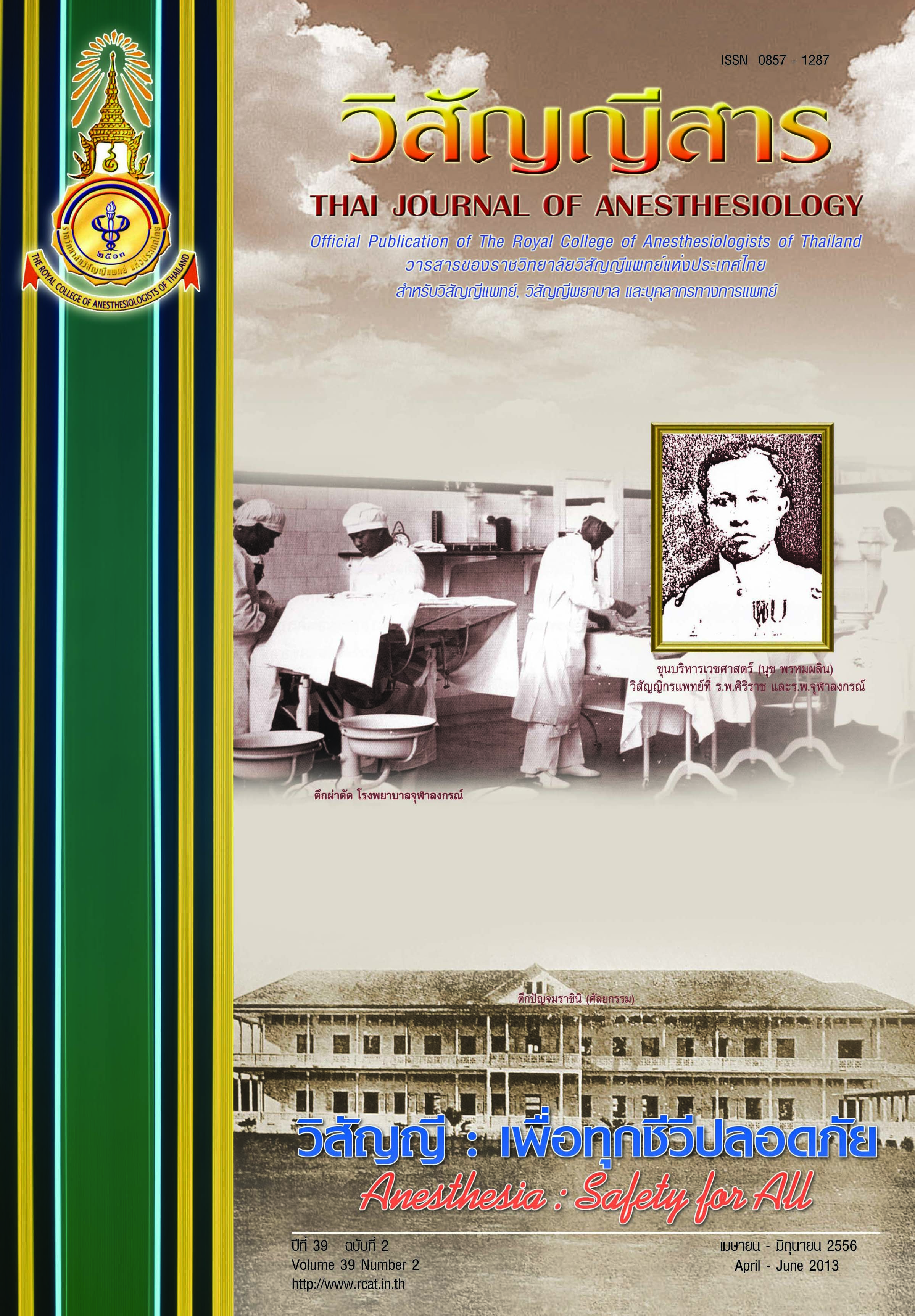Effectiveness of Fentanyl GPO TTS® in Chronic Pain Patients
Main Article Content
Abstract
Background: Fentanyl transdermal therapeutic system (TTS) has been effective in chronic pain patients as it provides constant release of the opioid for up to 72 hours. Due to a temporary shortage of morphine tablets in Thailand, in 2010, Fentanyl GPO TTS® was introduced. However, some patients reported that the duration was shorter than expected.
Objectives: The main objective of this study is to assess the effectiveness of Fentanyl GPO TTS® in terms of the duration and patient satisfaction to pain management.
Methods: The study was carried out for a period of 1 year starting from 1 June 2010 in chronic pain patients who were on Fentanyl GPO TTS® therapy. Pain score, daily oral morphine consumption for breakthrough pain, side effects and satisfaction score were evaluated at day 0 (patches application date), day 1, day 2 and day 3.
Results: Fifty - one patients were enrolled into the study. (26 females and 25 males) There was no difference in mean pain score at day 0 and day 3 (4.84 ± 2.74 and 4.24 ± 2.94 respectively, p - value 0.268). The difference in the average amount of morphine sulfate solution dose for breakthrough pain at day 0 (mean 13.56 ± 22.43 mg/day) and day 3 (mean 11.76 ± 21.51 mg/day) was not statistically significant (p - value 0.033). In addition, there was no statistically significant difference (p - value 0.194) in the number of patients requiring morphine sulfate solution for breakthrough pain on day 0, 1, 2 and 3. Most common side effect was constipation (65%). The mean satisfaction score was above 8 out of 10 in all studied days.
Conclusions: Our study showed that Fentanyl GPO TTS®, used in chronic pain patients, was effective for pain relief lasting up to 72 hours in addition to good satisfaction score rated by the patients.
การศึกษาประสิทธิภาพในการระงับปวดของแผ่นแปะ Fentanyl GPO TTS® ในกลุ่มผู้ป่วยปวดเรื้อรังรุนแรง
บทนำ: ปัจจุบันแผ่นแปะเฟนทานิลเป็นที่นิยมอย่างแพร่หลายในกลุ่มผู้ป่วยปวดเรื้อรังรุนแรง โดยการออก ฤทธิ์ของยาจะซึมผ่านทางผิวหนังและเข้าสู่กระแสเลือดในอัตราคงที่และสามารถระงับปวดได้ 72 ชั่วโมง ในช่วง 2 - 3 ปีที่ผ่านมา ประเทศไทยมีปัญหาการขาดแคลนยาแก้ปวดมอร์ฟีนชนิดรับประทาน จึงได้มีการนำ แผ่นเฟนทานิลเข้ามาใช้แทน นอกจากนี้ยังมีการนำ Fentanyl GPO TTS® เข้ามาใช้แทน Fentanyl TTS เดิม จากการติดตามผู้ป่วยส่วนหนึ่งที่ใช้แผ่นแปะเฟนทานิลดังกล่าว พบว่าไม่สามารถควบคุมอาการปวดได้ถึง 3 วัน ตามที่ระบุไว้
วัตถุประสงค์: วัตถุประสงค์หลักเพื่อประเมินประสิทธิภาพของแผ่นแปะ Fentanyl GPO TTS® ว่าระงับปวดได้นานถึง 3 วันหรือไม่ วัตถุประสงค์รองเพื่อประเมินอุบัติการณ์ของภาวะแทรกซ้อน และความพึงพอใจของผู้ป่วยต่อแผ่นแปะเฟนทานิล
วิธีการศึกษา: เป็นการศึกษาเชิงสังเกตไปข้างหน้า (Prospective observational study) ในกลุ่มผู้ป่วยปวดเรื้อรังรุนแรงทั้งผู้ป่วยในและผู้ป่วยนอกที่รับการรักษา จากหน่วยระงับปวด โรงพยาบาลรามาธิบดี ตั้งแต่ 1 มิถุนายน 2553 ถึง 1 มิถุนายน 2554 ทำการเก็บข้อมูล คะแนนความปวดเฉลี่ย, ปริมาณยาน้ำมอร์ฟีนเสริม, ผลข้างเคียงจากยา และ ความพึงพอใจของผู้ป่วย ณ วันที่ 0 (วันที่เปลี่ยนแผ่นยา) วันที่ 1, 2 และ 3
ผลการศึกษา: ผู้ป่วยเจ็บปวดเรื้อรังรุนแรงที่ไม่มีการปรับขนาดยา แผ่นแปะเฟนทานิลเพิ่ม จำนวน 51 คน เป็นเพศหญิง 26 คน เพศชาย 25 คน ส่วนใหญ่เป็นผู้ป่วยปวดจาก มะเร็ง (ร้อยละ 90) พบว่า คะแนนความปวดเฉลี่ย ณ วันที่เปลี่ยนแผ่นยาไม่มีความแตกต่างกับวันที่ 3 อย่าง มีนัยสำคัญทางสถิติ (mean 4.84 + 2.74 และ 4.24 + 2.94 ตามลำดับ, p = 0.268), ปริมาณเฉลี่ยการใช้ ยามอร์ฟีนน้ำ (Morphine sulfate solution) สำหรับลดอาการปวดแทรก (Breakthrough pain) ณ วันที่เปลี่ยน แผ่นยาและวันที่ 3 ไม่พบความแตกต่างกันอย่างมีนัยสำคัญทางสถิติ (mean 13.56 + 22.43 มก./วัน และ 11.76 + 21.51 มก./วัน ตามลำดับ, p = 0.033) จำนวนผู้ป่วยที่ใช้ยาแก้ปวดเสริมในแต่ละวันไม่มีความแตกต่างกัน อย่างมีนัยสำคัญทางสถิติ (p = 0.194) ผลข้างเคียงของยาที่พบมากที่สุด คือ อาการท้องผูก ร้อยละ 65 และ ความพึงพอใจเฉลี่ยของผู้ป่วยอยู่ในเกณฑ์ดีมากกว่า 8 คะแนน จากคะแนนเต็ม 10
สรุป: แผ่นแปะ Fentanyl GPO TTS® มีความสามารถในการระงับปวดอย่างมีประสิทธิภาพและปลอดภัยในกลุ่มผู้ป่วยเจ็บปวดเรื้อรัง รุนแรงได้ นานถึง 72 ชั่วโมง


